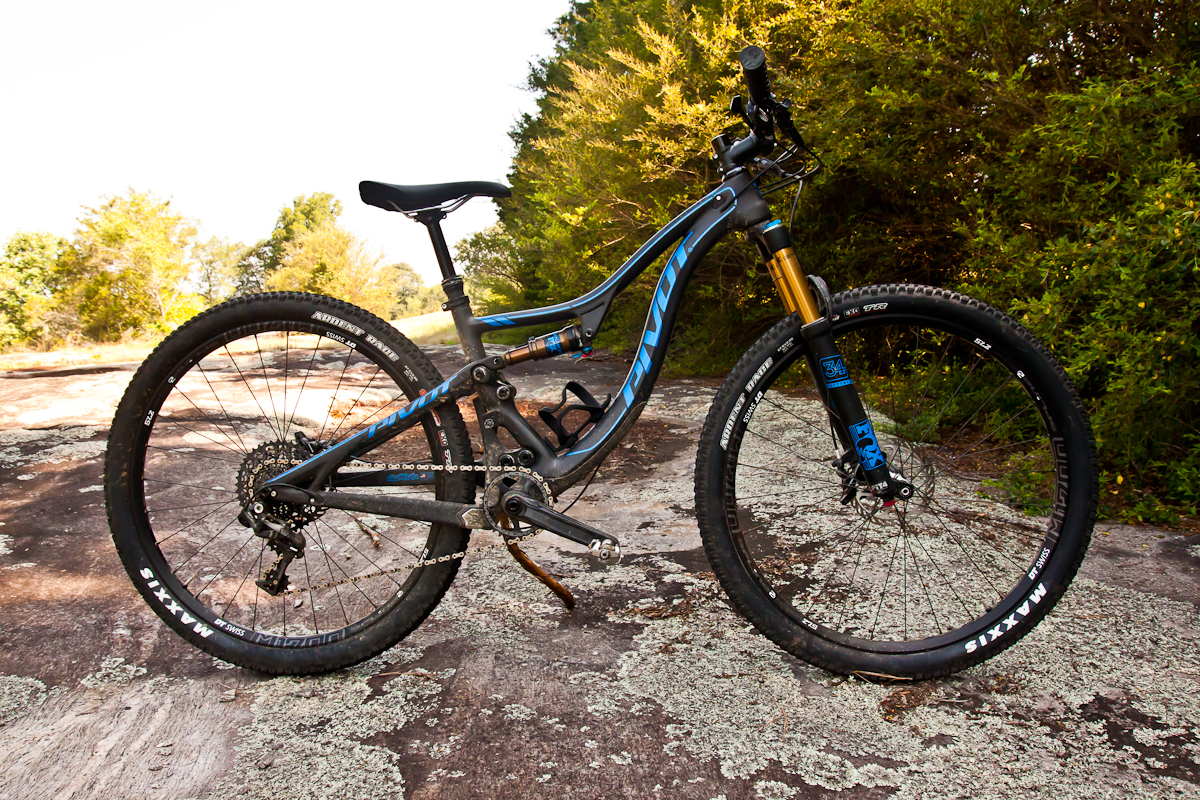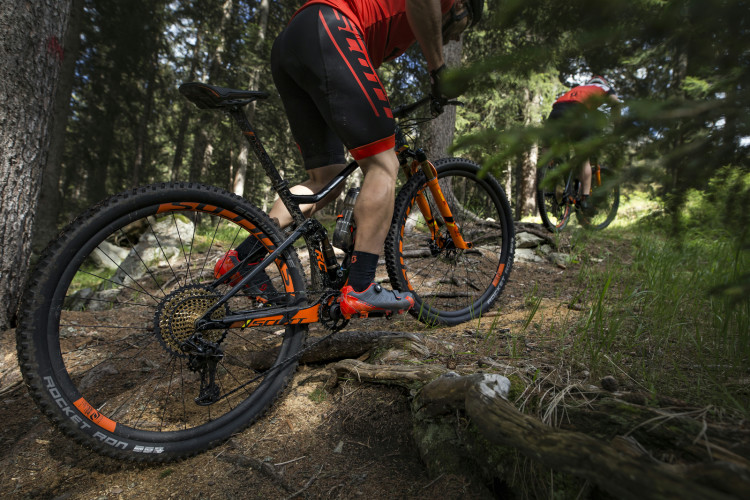
You don’t see a lot of mountain bike reviews from me here on Singletracks because for years I’ve struggled to find a bike that is light, capable, and most importantly, fits all 5-feet, zero-inches of my petite self. While it may not always be obvious what size bike one needs, in my case I’ve been watching and waiting for YEARS for the industry to figure out extra-small bikes with low standover height and “new tech” like 27.5 wheels. The struggle is real, y’all.
So imagine my delight when I found out Pivot makes a trail bike, the Mach 4, that has the lowest standover of any 27.5” suspension bike made.
The Mach 4 certainly isn’t new, but it’s a bike that checks all the boxes for riders like me who have been holding out to upgrade to a bike that has a tried and true design and is undeniably fast.
So Good-looking
I’ve been wondering which came first: the low standover design or the gracefully swoopy tube shapes? Either way, they work together to make the Mach 4 a thing a beauty. These curves give a smooth, flowy impression, and the matte black finish rounds out an understated look. The full internal routing keeps the bike’s lines clean and uninhibited, so as to not detract from the frame’s impressive bends.
Specs
The Pivot Mach 4 Carbon I tested is officially the fourth generation of this bike, and the original design is now nearly a decade ago. Originally an XC bike, the Mach 4 Carbon has evolved into doing double duty as a lightweight XC race machine and trail bike, thanks in part to the 27.5” wheels which allow for more aggressive trail riding. The extra-small frame has 100mm of optimized rear travel and includes a Fox 34 fork with 100mm of suspension up front. (For 2017, larger frame sizes come with 115mm of rear travel and 120mm or 130mm of front suspension.) Pivot offers nine high-performance builds, including Shimano Di2 and SRAM Eagle options (topping out at $9,799), and more affordable builds starting at $4,699 for the Race XT 1x group. Here are the key specs on the Mach 4 I reviewed (2016 group):
Frame: Mach 4 Carbon
Shock: FOX FLOAT DPS KASHIMA
Fork: FOX 34 FACTORY 27.5″ 100mm KASHIMA
Drivetrain: SRAM Rear Derailleur, X01, 11-Speed, Black/Silver
Crank: Race Face Turbine 30T, 170mm
Brakes: SRAM Guide RS
Dropper: KS LEV Integra (upgrade)
Wheels: DT Swiss X 1700 Spline Two
Tires: Maxxis Ardent Race 27.5×2.2 TR

Geometry
Over the years I’ve had to highly customize the part selection on my bikes to accommodate my size and weight, going beyond things normal riders do to their stock bikes like cutting down bars and putting on comfy saddles. For example, I routinely move my favorite fork that supports a 100lb rider from bike to bike, and I automatically install shorter crank arms and stems. Fortunately Pivot has already “optimized” their extra-small version of the Mach 4 for me, alleviating much of my need to customize anything.

First, speccing just 100mm of travel keeps low-standover possible while keeping the comparable head tube angle (68.5º with 100mm travel vs. 68.2º with 120mm travel), so I can have some fun on the downhills like the rest of you on your big bikes. But what if you want more travel, you ask? Don’t worry, now you can get the Mach 4 with 120mm and 130mm fork options. But for someone weighing 100 lbs, all that extra travel is overkill, in my opinion.
For short legs, guess what? 170mm crank arms. Thanks for thinking of me, Pivot. And the reach? Just over 15”. Thanks again Pivot, for not assuming I’m a gorilla.

Ride
Out of the box, I knew the Mach 4 was going to fly on the trails. My first ride out on the Dwelling Loop at Blankets Creek was thrilling and eye-opening. This trail is already pretty flowy, and you can really pedal hard and fast. Let me preface by saying I have not spent much time riding either 27.5” wheels or super-light carbon mountain bikes. The combination of bigger wheels and a lighter bike apparently made a huge difference for me, so much so that on that first ride I claimed QOM status. And that was just the warm-up.
On the more challenging Van Michael trail, I got to put the climbing and suspension to the test. On short, steep efforts I was able to stay in the saddle longer, if not for the duration of the climb, which is very atypical for me on climbs like “Hurl Hill.” Coming down, the bike was very stable and fast. It was obvious this bike could handle more. I needed bigger descents and… rocks.

Pisgah–home to big rocks, big climbs, and big descents–is the ultimate mountain bike testing ground. On longer days of riding in the mountains I was a bit worried about being limited by the 1×11 drivetrain. When fire roads seem endless and there’s yet another climb around the bend, I would think “ugh, I’m probably already in my granny gear.” But 99% of the time I was pleasantly surprised to find that I had one more click to an easier gear.
Since Pisgah is a temperate rain forest, there were inevitably wet spots. Unfortunately the Maxxis Ardent tires were a poor match for the wet rocks and wet roots. Having very little traction, I was definitely uneasy on slick tech sections. I could roll through most rock sections, but would have felt even more confident with a wider tire (even in dry conditions).
It didn’t take long to recognize the brilliance of having a dropper post, which is yet another new innovation to me. I gained a lot of confidence on downhills knowing that with the seat out of the way, I could lower my stance on the bike. Suddenly I was flying down the technical singletrack of Black Mountain without hesitation, dropper and rear travel working overtime.

Front suspension was another story. I experimented with different air pressures on the Fox 34, starting at the suggested 48 psi for my weight (which I extrapolated from the Fox tuning guide) and ended up at a near-ideal 40 psi, but still used only up to 80%-90% of the total travel. I took some bigger hits in Pisgah than local trails and never maxed it out in the 6 months of riding this bike. I suppose I could squeak out a little more travel if I had actually cut the bars down so I could distribute my weight more centrally. That aside, it was super easy to dial compression down for on and off road climbs, and likewise get back to plush riding mode.

Pros & Cons
Pivot was able to perfect the geometry and fit of the extra-small frame, and 100mm proved to be enough travel for even my hardest rides. Generally speaking, climbing on the Mach 4 was a breeze. The carbon frame and XC-rooted 68.5º head tube angle combined with the DW-link suspension efficiency to form a QOM (KOM)-dominating, climbing machine.

Downhill, the dropper post and wheel size were game-changers. I was part of the majority of mountain bikers that don’t own a dropper seat post and have now seen the light. I agree with Greg that dropper posts definitely make mountain biking more fun! Surprisingly, the dropper post is an optional upgrade for all the current Mach 4 builds. I recognize that a carbon seatpost offers weight and cost savings, but when I’m riding this bike on some serious descents like a true trail bike, then that dropper post is essential.
Pairing my extra-small geometry with the benefits of having the larger 27.5” wheels has been a huge advantage, now that I’m able to maintain higher speed and momentum through more challenging terrain. This may be the largest wheel size someone my size could get on a trail bike. Comparing the Mach 4 and its bigger sibling, the Mach 429, both bikes have similar amount of travel but the Mach 429 isn’t offered in an extra-small size. I can only deduce that the frame geometry would have to be significantly altered to accommodate the 29″ wheel size for smaller riders.
There are only two things I wish I could change about the Mach 4, and admittedly I should have done so early on in my testing. First, the saddle was not a good fit for me. Like clockwork, right around the 2-hour mark of any ride was when I would start feeling it. Fortunately, personalizing the saddle on this bike wouldn’t change its performance, but putting on my WTB Deva in place of the WTB Volt Race would have saved me from some unwanted soreness.
Second, the stock tires would have been an easy swap, too. The Maxxis Ardents roll fast and straight, but a wider or knobbier tire would have given me better cornering performance and improved traction in wet conditions.

Final Thoughts
If you’re on any one extreme end of the spectrum size-wise, then you totally get my frustrations of ill-fitting bikes and the hassle of having to customize so many details. Pivot has won my appreciation for getting the geometry spot-on for my fellow Lilliputians. But to all the giants reading this, there is one takeaway about the Pivot Mach 4 you should know: Efficiency. You’ll notice it in the near-effortless climbing and in the remarkable stability as you barrel down hills. Not too much travel, not too little. Juuuuust right.
The Mach 4 is like two bikes in one. Some days you just want sprint laps at your local trails. And other days you have bigger adventures planned with challenging tech and hella-fun downhills. Fortunately, with the Mach 4 there’s no need to commit to a single ride style, you can enjoy both cross country and trail riding!
MSRP: $6,399 (for the 2017 SRAM X01 Eagle build)





















3 Comments
Feb 17, 2017
Feb 17, 2017
Feb 23, 2017